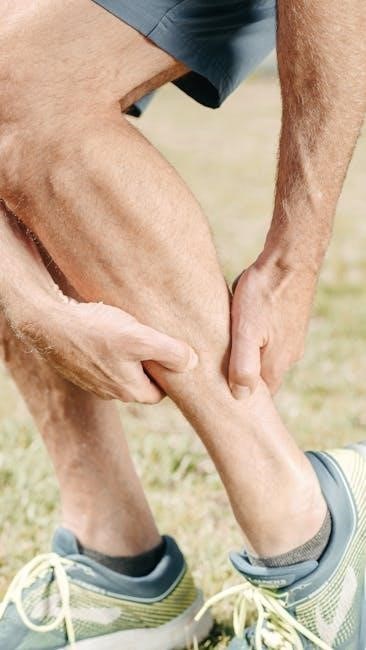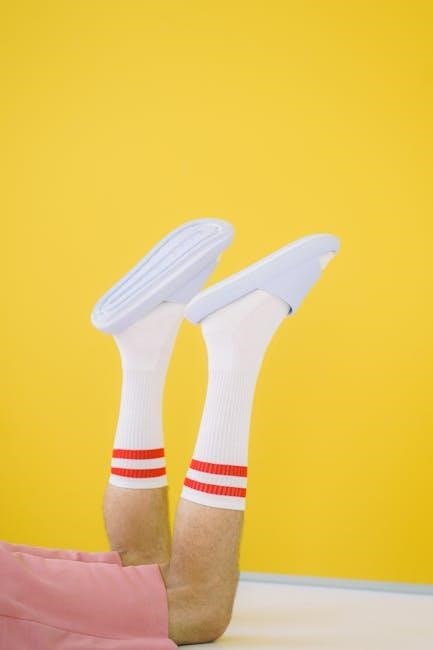Hip flexor stretches are essential for improving mobility, relieving tightness, and enhancing overall lower body flexibility. Regular stretching helps maintain healthy hip function and prevents common issues like lower back pain.
Understanding the Anatomy of Hip Flexors
The hip flexors are a group of muscles located in the anterior (front) region of the hip. The primary muscles responsible for hip flexion are the iliacus and psoas major, which work together to flex the hip and stabilize the pelvis. These muscles originate from the lower back (lumbar spine) and pelvis, attaching to the femur (thigh bone). The sartorius and rectus femoris also contribute to hip flexion, with the rectus femoris being part of the quadriceps group. Tightness or dysfunction in these muscles can lead to limited mobility, lower back pain, and poor posture. Understanding their anatomy helps in targeting them effectively during stretches to improve flexibility and reduce discomfort.
Why Hip Flexor Stretches Are Important

Hip flexor stretches are crucial for maintaining proper hip mobility and overall lower body function. Tight hip flexors, often caused by prolonged sitting or intense physical activity, can lead to limited range of motion, poor posture, and increased risk of injury. Regular stretching helps relieve tightness, reduces discomfort, and enhances athletic performance by allowing for more efficient movement. Additionally, flexible hip flexors can improve balance, reduce lower back strain, and promote better alignment during exercises like squats and lunges. Incorporating hip flexor stretches into a daily routine supports long-term joint health and prevents chronic issues such as anterior pelvic tilt. By addressing hip flexor tightness, individuals can maintain active lifestyles with greater ease and confidence.
Top Hip Flexor Stretches for Maximum Flexibility
Hip flexor stretches are simple yet effective exercises that relieve tightness and enhance mobility. The following section covers the top stretches to improve flexibility and reduce discomfort.
The Half-Kneeling Hip Flexor Stretch
The half-kneeling hip flexor stretch is a popular and effective exercise for targeting the hip flexors. Start by kneeling on one leg with the other foot flat on the ground in front of you. Ensure your back knee is directly under your hips for proper alignment; Tighten your core and gently push your hips forward until you feel a stretch in the front of your hip. Squeeze the glutes of the back leg to enhance the stretch and maintain a neutral spine. Hold this position for 30-45 seconds and repeat on the other side. Perform 3 sets daily to improve flexibility and reduce tightness. This stretch is particularly beneficial for individuals who spend a lot of time sitting or engaging in high-intensity activities. Regular practice helps prevent lower back pain and enhances overall hip mobility.
Standing Hip Flexor Stretch
The standing hip flexor stretch is a simple yet effective exercise for improving hip mobility. Stand tall with your feet shoulder-width apart. Take a large step forward with one leg, keeping your back leg straight and your front knee slightly bent. Place your hands on your front thigh for support. Lean forward slightly, squeezing the glutes of your back leg, until you feel a stretch in the front of your hip. Maintain a neutral spine and avoid arching your back. Hold the stretch for 30-45 seconds, then return to the starting position. Repeat on the other side. Perform 3 sets daily to enhance flexibility and reduce stiffness. This stretch is ideal for those who prefer standing exercises and want to improve posture and reduce lower back pain caused by tight hip flexors.
Lunges with a Hip Flexor Focus
Lunges with a hip flexor focus are a dynamic and effective way to stretch and strengthen the muscles in the front of the hips. Start by standing tall with your feet hip-width apart. Take a large step forward with one leg, lowering your body until your back knee nearly touches the ground. Keep your front thigh parallel to the ground and your back leg straight. Lean forward slightly, squeezing the glutes of your back leg, and feel the stretch in the front of your hip. Hold for 30-45 seconds, then return to the starting position. Repeat on the other side. This stretch targets the psoas major and iliacus muscles, improving flexibility and balance. Perform 3 sets daily to enhance mobility and reduce tightness. It’s ideal for athletes and individuals looking to improve their range of motion and overall hip health.
Seated Hip Flexor Stretch

The seated hip flexor stretch is a simple yet effective exercise for targeting the muscles in the front of the hips. To perform this stretch, sit on the floor with your knees bent and feet together, allowing your knees to drop to the sides. Place your hands on the ground in front of you for stability. Lean forward gently from your hips, keeping your back straight, until you feel a stretch in the front of your hips. Hold this position for 30-45 seconds, breathing deeply to relax the muscles. Repeat 2-3 times on each side. This stretch is particularly beneficial for individuals who spend a lot of time sitting, as it helps lengthen the psoas major and iliacus muscles, improving flexibility and posture. Incorporate this stretch into your daily routine to maintain healthy hip mobility and reduce tightness. It’s also a great option for those who prefer low-impact stretching exercises.
Side-Lying Hip Flexor Stretch
The side-lying hip flexor stretch is a gentle and effective way to target the hip flexors while lying on your side. Start by lying on your side with your legs straight. Bend the knee of the leg you want to stretch and pull your foot toward your glutes, keeping your hips aligned. Hold this position for 30 seconds to allow the hip flexor muscles to relax and lengthen. Switch sides and repeat. This stretch is particularly useful for individuals who spend a lot of time sitting or engaging in activities that tighten the hip flexors. It helps improve flexibility, reduces stiffness, and can be incorporated into both pre- and post-workout routines. For added benefit, focus on deep breathing to enhance relaxation and maximize the stretch. This stretch is also ideal for those who prefer low-impact exercises or are recovering from minor hip injuries.

Dynamic vs. Static Stretching for Hip Flexors
Dynamic stretches involve movement to enhance blood flow, while static stretches hold positions for extended periods. Both methods improve flexibility, reduce tightness, and prevent hip flexor-related injuries when incorporated into a routine.
Dynamic Stretching Techniques
Dynamic stretching involves active movements that mimic exercises or daily activities, preparing the hip flexors for action. Examples include high knees, lunges, and leg swings. These stretches improve blood flow, warm up muscles, and enhance flexibility. Unlike static stretches, dynamic movements are performed while moving, making them ideal for pre-workout routines. They help increase range of motion and reduce stiffness, especially for those with tight hip flexors from sitting or high-intensity activities. Techniques like step-ups or hip circles can also target the hip flexors dynamically. Regular practice improves mobility and reduces injury risk. Dynamic stretches are versatile and can be adapted to different fitness levels, making them a great addition to any exercise or stretching routine focused on hip health and overall lower body function.
Static Stretching Techniques

Static stretching involves holding a stretch for a period of time to lengthen the hip flexor muscles. These stretches are typically performed after a workout when muscles are warm. Hold each stretch for 20-30 seconds to maximize flexibility. Static stretches, like the half-kneeling hip flexor stretch, target the psoas and iliacus muscles, relieving tightness and improving range of motion. Seated hip flexor stretches and side-lying stretches are also effective for isolating these muscles. Regular static stretching can reduce muscle tension, enhance posture, and prevent lower back pain caused by tight hip flexors. Incorporating static stretches into a daily routine, especially after physical activity, promotes long-term flexibility and reduces the risk of injury. These stretches are ideal for individuals with sedentary lifestyles or those recovering from hip flexor strain, as they provide a gentle yet effective way to maintain muscle balance and overall hip health.
